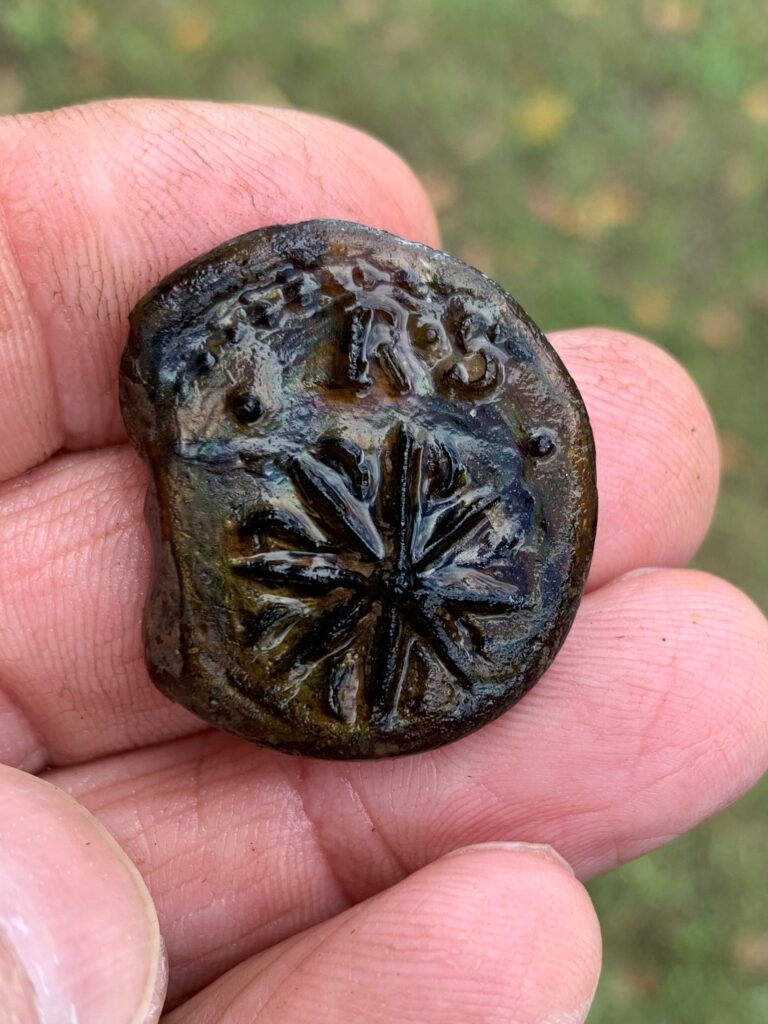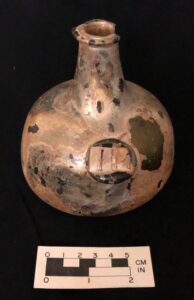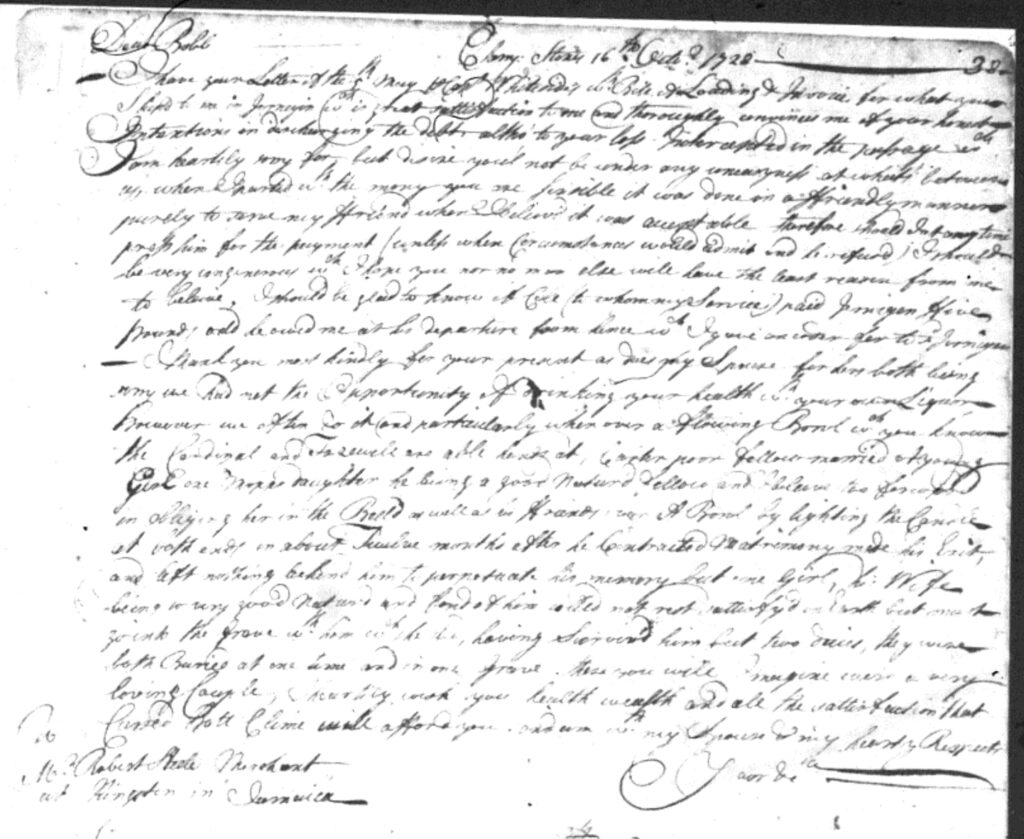Brand Identity in Colonial Virginia

After an 18th-century bottle seal with the initials R.S. was recovered from the Eyreville estate in Northampton County, Virginia, archaeologists set out to identify the individual behind the brand.
By Mike Clem | DHR Eastern Regional Archaeologist
DHR archaeological staff and other professionals made a short visit to the Eyreville estate in Northampton County on Virginia’s Eastern Shore in October 2023. We had been working at the site since 2017 save for a long interruption during the COVID-19 pandemic. During our visit in October, we assessed the site to map the features located within the vicinity of where we suspected the original house may have been built in the 1630s. The Eyreville site has been the subject of several field schools, and scholars have written about it over the years since its discovery. While our work during this visit involved very little excavation, we used trowels to “clean up” the area. This allowed us to identify and map features such as post holes, post molds, as well as other dark stains and anomalies in the soil that could help define the site, the structure that once stood there, and areas that were used for specific tasks during the site’s occupation nearly 400 years ago.
As we worked, we recovered a few artifacts, but one in particular stood out as unique—a small glass bottle seal. To date, the item is the only one of its kind that we’ve found at the Eyreville site. These seals were typically found on wine or liquor bottles. Made from molten glass, the seals were placed on the side of the bottle, somewhere around the mid-point. The glass was applied to a finished bottle before a metal stamp/die (generally made of brass, but sometimes ceramic or wood) was used to flatten it out and imprint a design, thus adhering it to the bottle and creating a distinctive impression. The bottle seals often featured a design that almost always included the initials or the name of the wine’s owner—not the maker, but the person who purchased a quantity of bottles and requested that the seal be made and applied to those bottles.

Laura Galke, former DHR Curator of Collections, recognized the artifact from Eyreville as an earlier version of colonial-era bottle seals. The seal features a design resembling a snowflake and includes the initials “R.S.” above the artwork. According to Laura, the earliest seals of this type date to the 1650s. The mid-17th century was a time when personalization of various material culture, including bottles, smoking pipes, pottery, and trade tokens, came into vogue. Early seals of the first decades of the 18th century often included a design and small initials. However, as time went on, seals began to solely incorporate the initials or name of the owner. Laura believes the die used to create the Eyreville seal was a custom-made metal version with designed letters as opposed to the standard alphabet die that was more common during the time. The impression on the seal is quite sharp and well-defined. Scholars have concluded that the practice of applying one’s personalized stamp on bottles was likely less about ownership and more about prestige. Certainly, many of these seals are found at homes not directly connected with the person for whom the seal was commissioned. In other words, the bottle seals seem to indicate that the wine and liquor were gifts meant to “show off” the status of the giver. After all, only the wealthiest individuals could afford to brand their bottles.
We were still unclear about the identity of R.S. Since historical records did not indicate that anybody with those initials had ever lived at the Eyreville estate, we assumed the bottle was a gift from a visitor, a neighbor, or a friend.
I sent a photo of the seal to Jenean Hall, a local historian and author on the Eastern Shore with research expertise on the early records of Accomack and Northampton counties. Her published books include An “Uncertaine Rumor” of Land and Another Day. Each publication features research on the early years of colonial life on Virginia’s Eastern Shore. In no time, Jenean responded to my question about the identity of R.S. with an answer that appears to fit.
Colonel William Kendall was the third owner of the property we now refer to as Eyreville. He purchased the land in 1657 and built two houses on the site before he died in 1686. One house—built by John Howe prior to 1637—already existed on the land before Kendall’s purchase. By the time Kendall arrived, the Howe house was likely unoccupied. It would have appeared as a post-in-ground structure of a variety that became known as a Virginia House. The lifespan of a house like this was typically not much more than 25 years. However, if the owner was so inclined, they could have extended its lifespan for some time with replacement posts and siding. Kendall possessed enough wealth to abandon this old house and build something more substantial. It appears that the old Howe house subsequently became the dumping ground for various household and farm waste. Archaeologists have been finding a great deal of detritus from the time that the Kendalls lived on the land at the site of the old Howe house.
Colonel Kendall’s grandson, also named William, married Sorrowful Margaret Custis before 1709, and they had several children. William died in 1720 and left the Eyreville property to his wife. William was around 33 years old when he died. Sorrowful Margaret then married Thomas Cable in 1723, and they lived together at Eyreville raising the children she had with Kendall. Cable and Margaret had an acquaintance by the name of Robert Steele. It is unclear how they knew each other, but Steele visited the couple at Eyreville in 1726.
In her research, Jenean found documents indicating that Steele was a merchant in Kingston, Jamaica, and owed Thomas Cable 28 pounds of Jamaican currency. Cable allowed Steele to pay this debt in sugar, molasses, and rum of equal value.
The following is a letter was written by Thomas Cable and addressed to Robert Steele. Transcribed by Jenean, the letter indicates that Steele sent bottles of rum and possibly other forms of liquor to Cable. The letter also indicates that this particular shipment was “intercepted,” which had a variety of meanings during the early 18th century, including piracy. We believe this letter demonstrates a relationship between Cable and Steele that included the sharing of liquor and other goods. Additionally, we believe that while the shipment described in the letter did not make it to Eyreville, other shipments may have been successful. It’s also likely that Steele brought the items along on his visit to the estate. Other letters allude to drinking parties at Eyreville with local guests. Taking all of this into consideration, it can be concluded that the R.S. on our bottle seal very likely came from a bottle sent to Cable by Steele at some point. Certainly the date of the letter (reproduced below) falls into the same time period of when the R.S. seal (and similar types) circulated.
•••
From the Thomas Cable Letterbook, page 38 microfilm,
Eastern Shore Public Library, Parksley, Virginia
[bracketed words or spaces are undeciphered]
>words inside angled brackets are guesses<
Dear Bobb [or Robb?] Cherry Stones 16th Octob 1728
I have your letter of the 5th May per Capt Whitendes wth Bill of Loading & Invoice for what you Ship'd to me in Jernegin wch is great sattisfaction to me and thoroughly convinces me of your honest Intentions in discharging the debt, altho' to your loss Intercepted in the passage wch I am heartily sorry for but desire you'l not be under any uneasyness at what's between us, when I parted wth the mony you are sensible it was done in a Friendly manner purely to serve my Friend when I believ'd it was acceptable therefore should I at any time press him for the payment (unless when Circumstances would admit and he refused) I would be very ungenerous wch I hope you nor no man else will have the least reason from me to believe, I should be glad to know if >Cole< (to whom my Service) paid Jernigen Five pounds odd he owed me at his departure from hence wch I gave an order for to sd Jernigen ___I thank you most kindly for your present as does my Spouse for hers both being sorry we had not the Opportunity of drinking your health wth your own Liquor however we often do it and particularly when over a flowing Bowl wch you know the Cardinal and Tazewell are able hands at , Carter poor fellow married A young Girl >one< Mapps daughter he being a good natur'd fellow and I believe too [_____] in obliging her in the [______] as well as his Friends over A Bowl by lighting the Candle at both ends in about Twelve months after he Contracted Matrimony made his Exit, and left nothing behind him to perpetuate his memory but >one< girl, [__] Wife being so very good natur'd and fond of him could not rest sattisfy'd on Earth but >must< go into the Grave wth him wch she did, having Surviv'd him but two daies, they were both Buried at one time and in one grave these you will Imagine ever a very loving Couple, I heartily wish you health wealth and all the sattisfaction that Cussed hott Clime will afford you and am wth my Spouse & my hearty Respect
Your &c
TC
To
Mr Robert Steele Merchant
at Kingston in Jamaica











